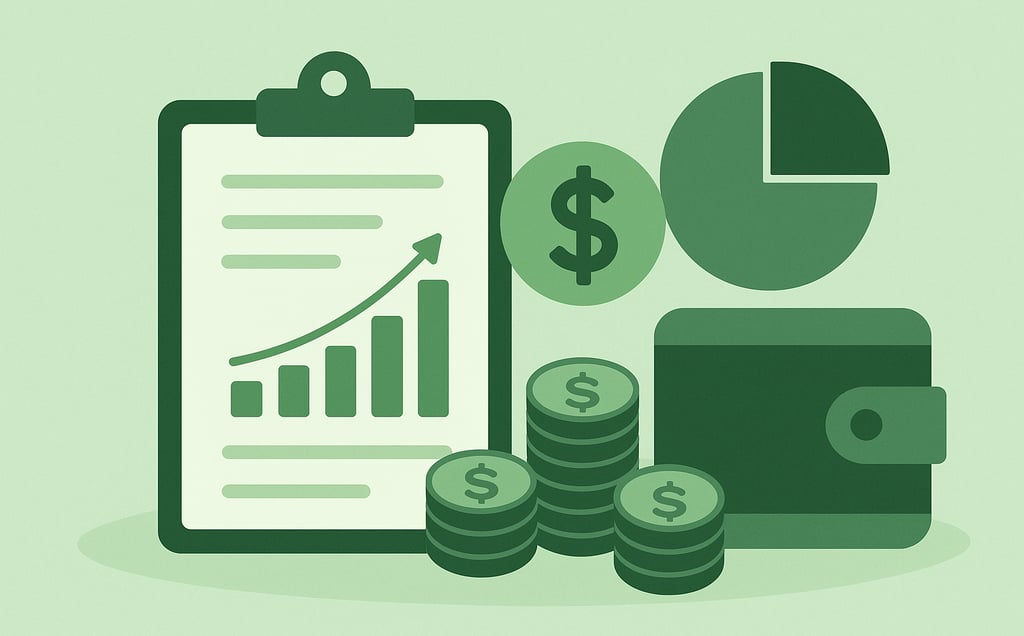How to Create a Financial Plan That Really Works
Discover how to create a financial plan that truly works and helps you achieve real stability. In this article, you’ll learn how to set clear financial goals, organize your income and expenses, and build an actionable plan that fits your daily life.
10/15/20253 min read


Financial success doesn’t happen by chance — it happens by design.
A solid financial plan is your blueprint for achieving stability, reducing stress, and building long-term wealth. Yet, many people struggle to create a plan that actually works for them. Why? Because they copy generic advice instead of designing a strategy that fits their goals, lifestyle, and income.
Let’s break down how to create a financial plan that truly works — one that helps you take control of your money and move confidently toward your future.
1. Understand Where You Stand
Before setting goals, you need to know your current situation. Gather all your financial information: income, expenses, debts, savings, and investments.
This might sound simple, but most people underestimate how much they spend. Track your spending for at least 30 days using an app or a simple spreadsheet. You’ll likely discover small leaks — those little, repeated expenses that silently eat your budget.
Tip: Don’t judge yourself during this step. Awareness is the first step toward progress.
2. Define Clear and Realistic Goals
Financial goals give your plan direction. Without them, your efforts are scattered.
Decide what you want to achieve in the short, medium, and long term. Examples:
Short-term (3–12 months): Build an emergency fund, pay off a small debt.
Medium-term (1–5 years): Buy a car, take a trip, start investing.
Long-term (5+ years): Buy a home, retire comfortably, achieve financial independence.
Be specific — don’t just say “save money.” Say “save $10,000 in 18 months.”
Clear goals make it easier to track your progress and stay motivated.
3. Build a Budget That Matches Your Life
A financial plan fails when it’s too restrictive. Instead of cutting everything you love, create balance.
Use the 50/30/20 rule as a guide:
50% of your income for needs (housing, food, transport)
30% for wants (leisure, dining out, entertainment)
20% for savings, investments, or debt repayment
If your income or expenses don’t fit this exactly, adjust — the goal is consistency, not perfection. The best plan is one you can stick with.
4. Prioritize an Emergency Fund
An emergency fund protects your plan from collapsing when life happens — like a job loss, car repair, or medical bill.
Ideally, aim for three to six months of expenses saved in a separate, easy-to-access account. This fund gives you peace of mind and prevents new debts when unexpected events occur.
5. Manage and Eliminate Debt Strategically
Debt can be one of the biggest obstacles to financial success.
List all your debts and prioritize repayment using one of these proven methods:
Debt Snowball: Pay off the smallest debts first to build momentum.
Debt Avalanche: Focus on debts with the highest interest rates to save money over time.
Choose the one that keeps you motivated — consistency matters more than the method itself.
6. Start Investing Early
You don’t need to be rich to invest — you become rich by investing early and regularly.
Even small amounts, when invested consistently, grow significantly through compound interest. Start with low-cost index funds or ETFs and learn as you go. Over time, investing turns your savings into a wealth-building machine.
7. Review and Adjust Regularly
Your financial plan should evolve as your life changes. Review it at least every three months:
Did your income change?
Are your goals still the same?
Are you saving and investing enough?
Small adjustments keep your plan alive and effective. Remember: a static plan fails, but an adaptable plan thrives.
Final Thoughts
Creating a financial plan that truly works isn’t about strict rules — it’s about building habits that align with your goals and values.
When you take control of your finances, you gain freedom. You stop reacting to money problems and start creating opportunities.
The best time to start was yesterday. The second-best time is today.
Take one step — review your spending, set a goal, or automate a transfer to savings.
Your future self will thank you. 💰
✅ Tip: Save this post or share it — so you can come back every few months to review your progress and refine your strategy.